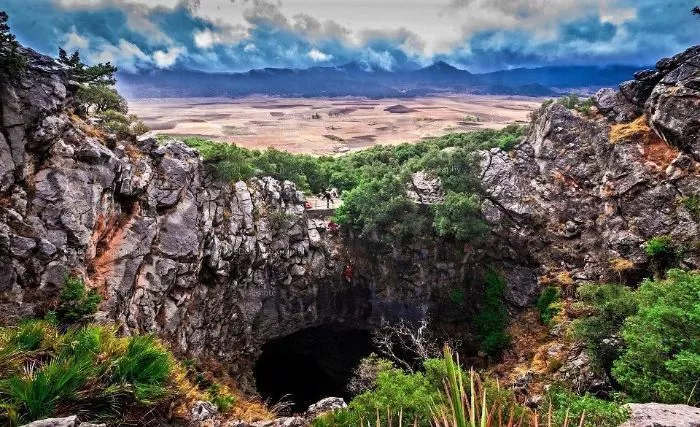There are a number of caves located in Morocco. The most famous cave is the Grotte des Cascades, which is located in the Toubkal National Park. Other notable caves include the Grottes de Hercules, the Grotte des Demoiselles, and the Grottes de l'Imouzzer.
Caving in Morocco is incredibly fun. Few people know about Morocco's sublime cavern system. Journey Morocco is a premier provider of personalized cave expeditions throughout Morocco. Your adventure awaits!
Read on to learn about some of the most incredible, legendary caves in Africa -- and the world.

Legend of the Cave of Hercules Cape Spartel, Morocco
Long assumed to have no bottom, the cave. A subterranean ley tube over 24 kilometers (15 miles) long that travels beneath the Strait of Gibraltar and exits in St. Michael's Cave in Gibraltar is thought to run through the cave. According to legend, this is how the Barbary macaques traveled from Morocco to the Rock of Gibraltar.
According to mythology, Heracles spent time resting in this cave before embarking on his 11th task—one of the 12 tasks King Eurystheus of Tiryns had assigned him—which involved obtaining golden apples from the Hesperides Garden, which some ancient Greek authors claimed was nearby at Lixus (one of the cities of Larache).
According to Greek mythology, Hercules went to Atlas and promised to support the skies so that Atlas may retrieve the apples from his daughters' Hesperides garden, which was watched over by the dragon Ladon. Atlas tried to mislead Hercules into carrying the sky permanently when he returned with the apples by proposing to distribute them himself. According to the myth, anyone who purposefully takes the load must bear it forever or until someone else takes it away.
By Roman tradition, Hercules had to traverse the mountain that was previously Atlas to reach the garden of the Hesperides. Hercules chose to break through the massive mountain rather than climb it using his incredible strength. He created the Strait of Gibraltar and linked the Atlantic Ocean to the Mediterranean Sea. Gibraltar makes up one portion of the split mountain, and the other portion is either Monte Hacho in Ceuta or Jebel Musa in Morocco (formerly known as the Mons Abyla).
Caving in Souss Massa, Morocco
Given the significance of the limestone outcroppings and the vast breadth of the karst networks they contain, the Souss Massa is a particularly conducive environment for caving. Chasms abound, drawing enthusiasts of caving.
Subject to obtaining the necessary authorizations, the nation of Ida Outanane (near Agadir) provides a variety of exploration opportunities. The Win-Timdouine Cave / Cave of the Lakes is now the most extended underground karst network in North Africa that is known. With its 19 km of galleries and numerous lakes arranged along them, it forms a massive network.
In Eddir (30.293961, -8.483926), exploration opportunities are also available with the Cave of Wonders and Tasserga (30.053847, -8.575226) with the Cave of the Cow.
Caving at Win-Timdouine Cave
It will be necessary to go through a guide to receive the cave's key from the local authorities in order to access the Win-Timdouine Cave. The cave's entrance has an artificial pool to get you in the mood right away.
The next step will require you to fully submerge yourself in chilly water, letting you forget the Souss Massa's intense sun. You will cross the first lakes of the active cave. You will cross some scree after the fourth lake to get to the chamber, the most stunning area in the cave, whose wonders merit all the work required to get there. The various drapes on the ceiling, with their delicate and symmetrical shapes, must then be considered.
It is important to note that exploration and visits to this cave are only permitted with official authorization.
Diamond Transfers and Tours has close relationships with cavers and spelunking experts who are highly knowledgeable about caves and permits required in Morocco.
Friouato Caves, Taza Province, Morocco

The "Grotte Friouato" or Friouato Caves, as they are more commonly referred to, are a group of underground spaces between the Rif and Middle Atlas mountain ranges outside the northern Moroccan city of Taza.
Taza, which served as the capital under the Almohad and Merenid kingdoms, has a reputation for being strategically significant due to its location between two mountain ranges. The trip to the caves can be challenging due to the steep terrain. The Friouato Caves may require several Grand Taxi trips to reach, but the underground setting and surrounding scenery are well worth the journey.
In 1969, a party from Exeter University went spelunking and found new areas of the caves, including wide-open chambers and a pile of boulders. Large limestone tables and calcium carbonate stalactites and stalagmites are waiting to be discovered inside the cave system.
Diamond Transfers and Tours can arrange for an expert local guide in Taza to explore the caves with you.
he Friouato Caves are one of the largest cave systems in North Africa and go down more than 270 meters. The caves' actual boundaries are still up for debate, though. The history of this cave's exploration is also shrouded in obscurity. When the people of Taza first found the cave network is unknown. Norbert Casteret led one of the earliest known explorations of the caves in 1930, reaching 146 meters and finding the caverns' underground river.












































Comments